|
Asia
is the largest continent on earth. Along with its
eastern and the far larger land mass known as Eurasia,
it extends from Arctic Ocean in the north to Indian
Ocean in the south. It stretches from the shores of the
Mediterranean in the west to Pacific Ocean in the East.
Embracing one third of the earth's land surface, it
covers an enormous area of seventeen million square
miles-and holding over half of its population-its
inhabitants numbering into thousands of millions-it
displays every form of variety, scenic, climatic and
racial.
From the very early times,
Asia has been known as the cradle of human civilization.
It is also the birthplace of the world's greatest
revealed religions, Judaism, Christianity and Islam.
Nature has worked here mightily. Mountains, deserts,
rivers and forests almost obscure the work of man by the
reason of their vastness. However, man's labors in Asia
have been sufficiently striking, for its inhabitants
have created a storied history of and a treasury of art
and achievement. Today, Asia's ancient architectural
treasures are present in unsurpassed abundance for all
to see and lie by the side of man's most modern
achievements.
In the Arab World, Syria
was the land of the ancient Phoenicians who founded the
city of Carthage and invented the alphabet. It is
unrivalled for its archaeological riches. At Baalbek,
the ancient Heliopolis in Lebanon is one of the most
magnificent relics of the Roman occupation. Damascus,
the capital of Syria and the oldest living city in the
world, is renowned for its garden, its "damascene"
sword-blades, and its mosaic decorated Umayyad Mosque.
The Holy Land of Palestine
is only slightly larger than Wales but is of worldwide
renown as a land that is holy to Islam, Christianity,
and Judaism. But it is in Jerusalem, "the joy of the
whole earth" that the chief interest centers. The Jews
and the Christians consider the land holy as it contains
some of its religious and historical sites. The Dome of
the Rock and the famous Masjid al-Aqsa found in the Old
City of Jerusalem is the most sacred place of worship to
Muslims after the cities of Makkah and Madinah.
On the eastern boundary is
the great rift, the torrid valley of Jordan, one of the
world's chief wonders. The River Jordan flows through
the Sea of Galilee into the Dead Sea, which lying 1292
feet below the level of Mediterranean, is the lowest
spot on the earth's surface and one of the most
desolate. Today, the waterpower of the River Jordan is
being harnessed; the Potash deposits of the Dead Sea,
which is five times as salty as the ocean is being
exploited. Jordan also includes within its boundaries
Petra, "the rose-red city, half as old as time," whose
rock-hewn buildings are startling relics of a remote
outpost of the Greek-Roman civilization.
Among the kingdoms of
Arabia, the huge southwestern Peninsula of Asia, the
largest is Saudi Arabia, formed by the union of the
lands of Najd in Central Arabia with the Hejaz, which
adjoins the Red Sea, and possesses the chief port of
Jeddah, along with the two holiest cities of Islam,
Makkah and Madinah. It is obligatory for every Muslim to
make a Pilgrimage to Makkah, if he can afford it, once
in his lifetime. Madain Saleh, another Nabatean city in
Arabia, contains tombs believed to have been carved
between 100BC and CE. About half the area of Arabia is
an arid, uninhabitable desert.
Farther south is Yemen,
the Arabia Felix of the ancients. And, at its southwest
corner guarding the approach to the Red Sea, is the Port
of Aden. In the interior of the Hadhramaut, the southern
coastal region in Shibam, are strange skyscraper cites,
where Arab millionaires who had made their fortunes by
trading overseas have lived.
The Arab Republic of Iraq,
the ancient Mesopotamia, is an alluvial plain between
the mighty rivers of Euphrates and Tigris. Iraq was the
seat of the remarkable Sumerian culture centered at Ur,
which dates back to five centuries BC. Later followed
the empires of the Babylonians and Assyrians, who have
built great cities like Babylon, Ashur, Nineveh and many
others-the ruins of which miraculously survive to this
day. Its capital Baghdad is the fabled city of the
Caliph Harun al-Rashid, celebrated in the Arabian Nights
with wonderful stories. To the north of Baghdad is the
oil rich city of Mosul with its ancient architectural
wonders.
Adjacent to the continent
of Asia is Africa, which is third in size among the
continents of the world. Its 11,500,000 square miles of
area is sparsely populated for much of Africa's surface
is desert or thick equatorial forests leaving only a
small area fit for habitation. It is surrounded by water
on all its sides. The Sinai Peninsula forms a land
bridge between the continents of Asia and Africa and has
cut to construct the Suez Canal, one of the great feats
of modern engineering in the world. The Suez links the
Mediterranean with the Red Sea and shortens the sea
route to India and Far East by nearly 6000 miles. It has
become today one of the principal arteries of world
trade.
The continent of Africa is
made up of astonishing marvels, whose lakes, waterfalls,
rivers, mountains and deserts rival any to be found on
earth. It is also believed to be the real cradle of
human race by many anthropologists. There are relics of
ancient civilizations along the northern and
northeastern coast of Africa, which are unsurpassed in
its size, antiquity and number.
With the advent of Islam
in Arabia came a great wave of Arab conquerors. They
marked North Africa with a lasting stamp and gave it the
Religion of Islam in its most permanent form. Few
regions of the Muslim world can boast a finer series of
mosques than the Hasan Tower at Rabat, the Kutubiya
Mosque of Marrakesh, the Kairwan Mosque at Fez, the
ruined tower of Mansura and the Great Mosque at the most
Arab of all Arab cities Qairouan in the present day
Tunisia.
At the northeastern corner
of Africa is Egypt, and the country has been best
described by Herodotus, the great Greek historian as the
"the gift of the River Nile." For, were it not for the
river and the silt it carries down from the Ethiopian
highlands, Egypt would have been an empty desert. On its
journey the Nile passes through nine different countries
and its flow regulated by the epic creations of modern
engineering the Aswan High Dam and the Assiut barrage.
Egypt's dry sunny climate
has preserved for us the buildings, sculptures,
paintings, tombs and records of a wonderful civilization
that arose seven thousand years ago and lasted until the
beginning of the Christian Era. Here we find the Great
Pyramids and the mysterious Sphinx. Roman occupation and
early Christianity (Coptic) have left their mark in
Egypt, but as in the case of other North African
countries, it is the Religion of Islam and the Arab
culture that gives it it's present character.
Cairo, the capital of
Egypt, is the metropolis of Arab civilization besides
being the greatest city in Africa. With its fort built
by Salahuddin, its busy bazaars, its tombs of the Muslim
kings and the great Al-Azhar University, there is no
more a happy hunting ground for the student of Islamic
art and architecture. Cairo has an endless array of
mosques of all centuries-from the ninth to the twentieth
century. Among the mosques of Cairo the most famous are
the Ibn Tulun Mosque with its exquisite arcades, the
grandest of all mosques built by Sultan Hasan and the
Alabaster mosque
These are but a few of the
marvels of the Arab World that make the continents of
Asia and Africa a rich storehouse of amazing wonders!
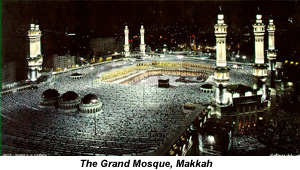
THE CITY OF MAKKAH:
Makkah is the spiritual
capital of the Muslim world, a land made noble and
blessed by Allah. It is the cradle of monotheism (faith
in the worship of One and the Only God). Its history has
been traced back from the very dawn of humanity to Adam,
the father of mankind and the world's first prophet, who
according to tradition was the builder of the Ka'bah.
The original Ka'bah was destroyed by the Deluge and
later re-built by Prophet Abraham and his son Ismael.
According to the Holy Qur'an it is "the first temple
established for the people" for the worship of One God.
It was also here that Prophet Mohammad (peace be upon
him) was born and received the first verses of Divine
Revelation that was to change forever the face of the
world.
The city of Makkah has
several different names. It is referred in the Holy
Qur'an as "Umm al-Qura" (the Mother of Cities), "Al-Balad
al-Ameen" (the city of Peace or Safety), "Al-Bayt al-Ateeq"
(the Ancient House), and "Al-Bayt al-Haram" (the Sacred
Sanctuary). It is also known by the name of Umm al-Rahmah
(the source of Mercy), "Al-Raas" (the Head: i.e. the
Origin), "Al-Aqdas" (the Holy of Holies) and "Al-Muqaddassah"
(the Sacrosanct).
There is no other place in
the whole world, which has been so honored and respected
by the Muslims as Makkah. Five times a day, hundreds of
millions of Muslims all over the world turn to face the
very heart of the city, which is the Ka'bah the "Al-Haram
al-Shareef", the "blessed sanctuary which fives guidance
to all beings". All those who turn to face Ka'bah hope
that some day God will grant their prayers and the
immense privilege of going to the Holy City to perform
the obligatory duty of Hajj-the fifth pillar of Islam.
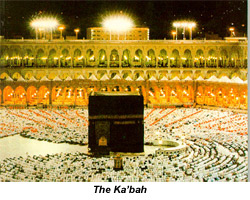
THE KA'BAH:
The Ka'bah or Bayt al-Haram
(Sacred House of God) is almost in the shape of a cube
measuring about thirteen meters in length, twelve meters
across, and fifteen meters in height. It is shrouded
almost down to its base in a rich black drapery, the
Kiswah, on which are embroidered in gold threads,
quotations from the Holy Qur'an. The Ka'bah possesses a
single door, about two meters from the ground, probably
as a precaution against floods. Once the pilgrim has
crossed the threshold of the Sacred Sanctuary, he will
catch sight of the Ka'bah in the center of the inner
courtyard of the Haram, an unforgettable vision to its
visitors.
The Hijr-e-Aswad is a
Black Stone mounted on the Ka'bah set in silver and is
at a distance of more than one meter from the ground.
Pilgrims starting their circumambulation around the
Ka'bah use it as a starting point to commence the rites
of Hajj. According to a tradition of Prophet Mohammad (pbuh),
the stone was brought by Archangel Jibreel (Gabriel)
from Paradise and given to Adam. It is said the first
man kept it and passed it on to his descendants.
It is reported that
Prophet Mohammad, on his Farewell Pilgrimage had raised
his hands to the heavens and prayed: "O Allah, increase
the dignity of this Thy House, and its honor and renown,
and its majesty, and its eminence, on the part of those
who accomplish the Hajj and the Umrah."
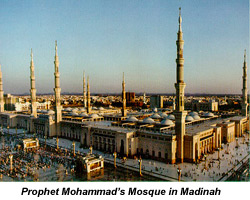
THE CITY OF MADINAH:
Madinah al-Munawwarah,
located 447 kilometers from Makkah, is the second
holiest city of Islam; beloved to all Muslims, for it
was in this city that Prophet Mohammad (pbuh) found
refuge after his migration from Makkah. It was from its
base that the Religion of Islam expanded to Makkah and
later to other parts of the world. It was also at
Madinah that Prophet Muhammad (pbuh) was buried after he
passed away from this earth along with a sizeable number
of his close Companions.
In ancient times, Madinah was known as Yathrib, famous
as a major halting place for the caravans bound for
Yemen and Syria. The Holy Prophet called it "Madinah-al
Munawwarah" (the enlightened, illustrious city). Some of
the other names of Madinah are "Madinattu-n-Nabi" (City
of the Prophet), and "Dar as-Salam" (the House of
Peace).
The Mosque of the Prophet
(Masjid-e-Nabawi), which he built with his own hands and
later enlarged, is also located at Madinah. According to
a tradition of the Holy Prophet Mohammad one prayer in
this particular mosque is worth a ten thousand prayers
anywhere else, with the exception of the Great Mosque at
Makkah (where a single prayer is worth a hundred
thousand recited elsewhere) and Masjid al-Aqsa where a
single prayer is equivalent to one thousand prayers said
elsewhere. Almost all the pilgrims who go on Hajj to
Makkah make it a point to visit Madinah, which makes
this city a unique wonder in the Muslim world.
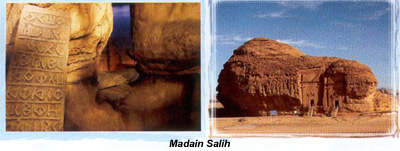
MADAIN SALIH:
The ancient city of Madain
Salih is located in the province of Tabuk several
hundred kilometers north of Madinah in Saudi Arabia. It
was a halting place for trading caravans that passed
through this route from the incense-producing areas of
southern Arabia to Syria, Egypt, Byzantium and other
points. They dwelled in plains in the summer and cut
their houses in mountains to seek refuge during the
winter season. The immense stone tombs found here are
believed to have carved between 100BC and 100AC and the
city itself was the second city in the Nabatean Empire,
after Petra in modern-day Jordan.
It is also identified as
the place where a Prophet, by name Salih, mentioned in
the Holy Qur'an (7:71), was sent by Allah (swt) to
counsel to the wayward tribes of Thamud. The people of
Thamud refused to heed his words and rejected him as a
prophet. As a result, they invited on themselves the
wrath of Allah and their city was destroyed by a violent
convulsion, and a cry from heaven. The next day they
were found lying prostrate in their dwellings and dead.
According to tradition,
the tribes of Thamud challenged Prophet Salih to produce
for them a big pregnant she-camel from the rocks nearby.
They swore that if the Prophet brought the miracle to
pass they would all believe in him. Prophet Salih prayed
to Allah and his prayers were heard. The rocks shuddered
as if in labor and a she-camel came forth. Some among
the Thamudites believed in Salih and accepted him as a
Prophet, whereas, the majority among them rejected him.
They lamed the camel and killed her. It is said that her
young foal came forth from her womb unharmed and
vanished into a rock. The great rock still stands as a
landmark on the western side of the valley, its summit
close to a thousand feet.
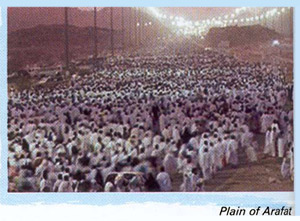
THE PLAIN OF ARAFAT:
The gathering of millions
of Hajj pilgrims on the ninth of Dhul-Hijjah on the
plains of Arafat, near Makkah presents an amazing
spectacle to an onlooker. It is the meeting place of the
Pilgrims from
different parts of the Muslim world who annually come to
perform the Hajj, or the Great Pilgrimage at Makkah,
which is enjoined on every Muslim (who can afford it)
once in a lifetime. The "Standing at Arafat" is the
chief rite of the Hajj. When asked about this rite,
Prophet Muhammad (pbuh) replied: "The Hajj is Arafat."
The Hajj Pilgrims spend the entire day in prayers,
reading the chapters from the Holy Qur'an and invoking
God in their quest of Absolute Forgiveness.
|
